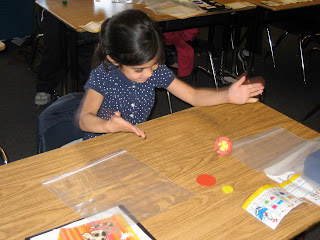MSAP PROJECT: BALANCE AND MOTION
JOHNSON STEM MAGNET SCHOOL
MRS. CATHLEEN POST
2ND GRADE
Objective: Through trial and error students will discover numerous ways to balance tag board (two dimensional) shapes using balance and counterbalancing techniques. They will be able to predict how an object will balance based on previous experience and an observed pattern. They will communicate observations and comparisons of balanced objects, using precise vocabulary.
Content areas: PHYSICAL SCIENCE, INVESTIGATION AND EXPERIMENTATION
Standards: PS1A, B, C, E and I&E 4A, 4B, 4G, 4D
Project grouping: INDIVIUAL AND PARTNERSHIPS
Technology used: DOCUMENT CAMERA AND INTERACTIVE WHITE BOARD (for demonstrations and modeling of investigations, watch movie from United Streaming site), STUDENT LAPTOPS (research on balance and motion), DIGITAL CAMERA (to take pictures and video documenting our learning), MAC BOOK (to blog about our learning in B15 and MSAP project), classroom LASER PRINTER (to print out Balance and Motion Student Notebooks).
Support received from staff: REBA MATHEWS (introduced Blogger at a Staff Development Meeting and trouble shooting), Dondi Jones (helped with document camera and whiteboard, also fixing student laptops.)
Technology used: DOCUMENT CAMERA AND INTERACTIVE WHITE BOARD (for demonstrations and modeling of investigations, watch movie from United Streaming site), STUDENT LAPTOPS (research on balance and motion), DIGITAL CAMERA (to take pictures and video documenting our learning), MAC BOOK (to blog about our learning in B15 and MSAP project), classroom LASER PRINTER (to print out Balance and Motion Student Notebooks).
Support received from staff: REBA MATHEWS (introduced Blogger at a Staff Development Meeting and trouble shooting), Dondi Jones (helped with document camera and whiteboard, also fixing student laptops.)
For the past few weeks we have been investigating balance and motion.
Students have explored the concepts of balance, counterbalance, counterweight, and stability by balancing tag board shapes, making mobiles (in Science Lab), and engaging in other balancing projects.
Students were challenged with finding the balance point of a crayfish cutout. They had to figure out how to balance the crayfish on it's edge, its tail, and its "nose", using clothespins as counterweights. After solving this problem, they had to use what they learned about balance and counterweights and apply it to a cutout of an arch and triangle. The final experiment was to balance a pencil on its point in a stable position using only a soft wire and clothespins.
We are currently exploring variables that influence the spinning of tops, zoomers, and twirlers. We are gaining experience with a force as a push or pull. We are also learning that gravity is a pulling force.
Through our BALANCE investigations we have learned that:
(above pictures show students investigating balance and counterbalance)
- Something is balanced when it stays in a position on its own without being held there.
- The clothespins (counterweights) should go low on the tag board shapes to make them balance.
- You can tell something is in a stable position if the counterweights are below the balance point.
- The trick to balancing anything is to add counterweights below the balance point.
(above pictures show students experimenting with Spinners, such as tops, and researching motion of spinners)
So far we have concluded that:
- You need force to start a top spinning.
- Fast spinning and bigger tops are more stable than the small slow ones.
- Both tops and zoomers spin.
- Tops are put in motion by pushing the shaft around. Zoomers are put in motion by pulling on the string. Both need FORCE to start.
- You can speed up a zoomer by pulling on the string with more force.
Our next investigation....Twirlers! (How are twirlers, zoomers and tops the same? What makes twirler wings and twirly birds spin?)







No comments:
Post a Comment